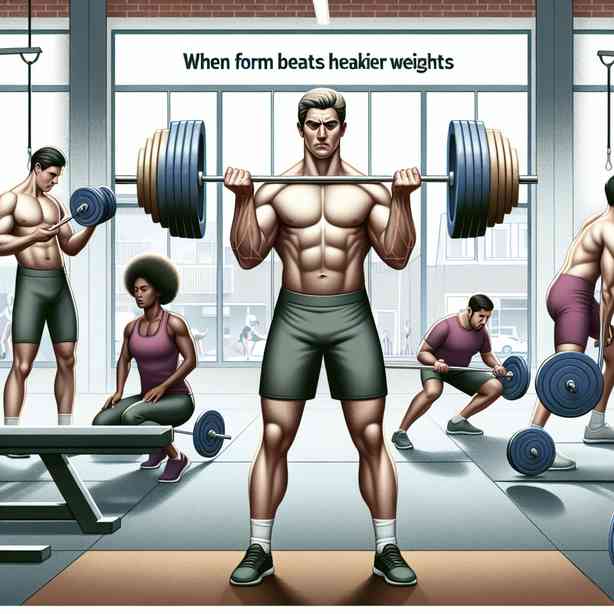
When it comes to strength training and fitness, there’s an age-old debate that continues to resonate among newcomers and seasoned athletes alike: the importance of proper form versus the allure of lifting heavier weights. While it might seem enticing to pile on the weight plates to showcase sheer strength, developing a strong foundation through correct form can often yield better results both in performance and long-term health. In this discussion, we will delve into why form often beats heavier weights and how this principle can guide you on your fitness journey.
Proper form is the cornerstone of any successful weight training regimen. When you execute an exercise with correct technique, you efficiently target the intended muscle groups, allowing them to engage fully and progress in strength and endurance. For example, consider the humble squat. A well-executed squat prioritizes form over the amount of weight lifted. If a lifter chooses to sacrifice their technique by leaning too far forward or rounding their back, they not only risk injury but also diminish the effectiveness of the exercise by failing to engage the core and glutes properly.
This principle extends beyond simple aesthetics; engaging in proper form significantly minimizes the risk of injury. Studies have shown that improper lifting techniques often lead to strains, sprains, and chronic injuries—problems that can set back a fitness enthusiast’s progress for months or even years. In contrast, consistent practice of correct form promotes proper muscle function and helps protect joints, ultimately leading to a sturdier physique. This protective aspect is particularly vital for beginners who are still developing their understanding of their bodies and how they respond to resistance training.
Another crucial factor to consider is muscle memory. When you practice exercises with correct form, you build strong neural pathways that enhance your muscle memory. This building block is essential for athletic performance; it enables you to execute movements more efficiently and fluidly, preparing you for more complex physical challenges. Conversely, if you continuously lift weight without regard to form, those neural pathways may reinforce bad habits, making it much harder to retrain your body into performing correctly later on.
In terms of muscle development and hypertrophy, lifting with proper form often proves to be more effective. With good form, you can fully engage the muscle fibers targeted during the exercise, leading to increased muscle activation. For instance, let’s take a look at the bench press. A lifter who uses correct form, ensuring their elbows are at an angle that supports their shoulders and keeps their feet planted firmly on the ground, can activate their chest, shoulders, and triceps more effectively than someone who flails their arms or arches their back excessively. Over time, consistent engagement of specific muscle groups can lead to better development and growth, far exceeding what could be accomplished with heavy, improper lifts.
Moreover, focusing on proper form allows for progressive overload—the gradual increase of stress placed upon the musculoskeletal system to ignite muscle growth. By mastering the correct technique, an individual can begin with lighter weights and then increase resistance gradually as their strength and confidence develop. This approach not only reinforces good habits but also ensures that every repetition leads to effective muscle engagement, paving the way for sustainable progress without unnecessary setbacks.
Additionally, incorporating a variety of exercises while maintaining proper form can enhance overall functional strength. Functional strength is the ability to perform daily activities effectively and with ease. It’s important to integrate movements that mimic real-life situations, such as lifting grocery bags or climbing stairs. By prioritizing form throughout various exercises, you develop a more balanced strength foundation while building coordination and stability. This translates into an improved quality of life and reduces the risk of injuries during everyday tasks.
It’s also worth mentioning the psychological impact of lifting with proper form. Training correctly fosters a sense of achievement and boosts confidence. When individuals realize they can maintain impeccable form while performing a challenging lift, they are likely to push their limits further, embracing opportunities for growth. In a fitness environment where experimentation is encouraged, cultivating the mindset that values correct technique can set the tone for long-term dedication to health and fitness goals.
In the realm of strength training, ego lifting—doing heavier weights to impress others rather than for personal progression—can detrimentally affect your growth and diminish your commitment to fitness. The fitness community is often filled with distractions that may tempt individuals to raise their weights above their capacity. This behavior encourages a cycle of limiting gains and can lead to plateauing. Instead, prioritizing form allows one to stay focused on individual progress and development.
In conclusion, while the temptation to lift heavier weights is alluring, maintaining proper form should always take precedence. The benefits of good technique encompass reduced injury risk, enhanced muscle engagement, better strength gains, and improved overall functional fitness. As you progress on your fitness journey, remember that consistency and dedication to correct form can yield remarkable results over time. Trust the process, prioritizing quality over quantity, and you will pave a path toward sustainable strength and well-being that ultimately leads to greater achievements in your fitness endeavors.
Lastly, it’s essential to maintain a balanced approach to training, not only focusing on resistance training but also incorporating other facets of fitness such as flexibility, cardiovascular fitness, and recovery. Engaging in a well-rounded routine will further bolster your gains and support your long-term health goals. So as you step into the gym or embark on your next workout session, keep in mind that the journey is just as important as the destination, and every rep performed with care brings you closer to your aspirations.


